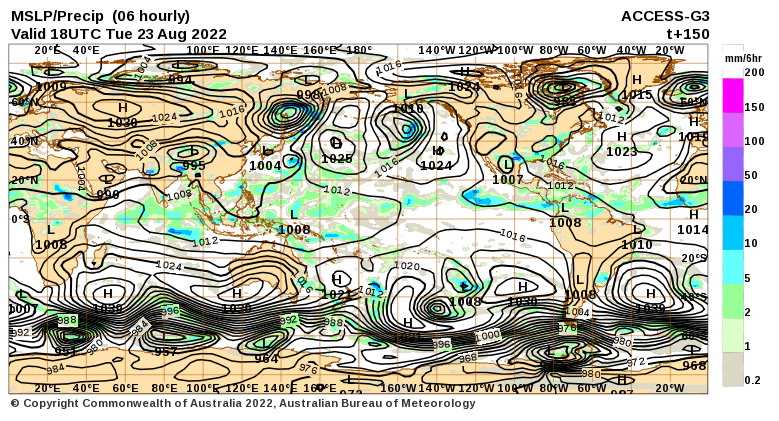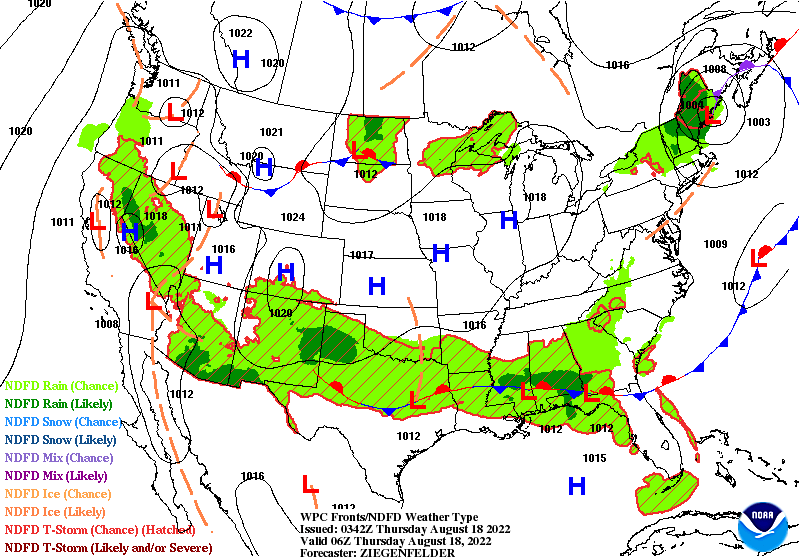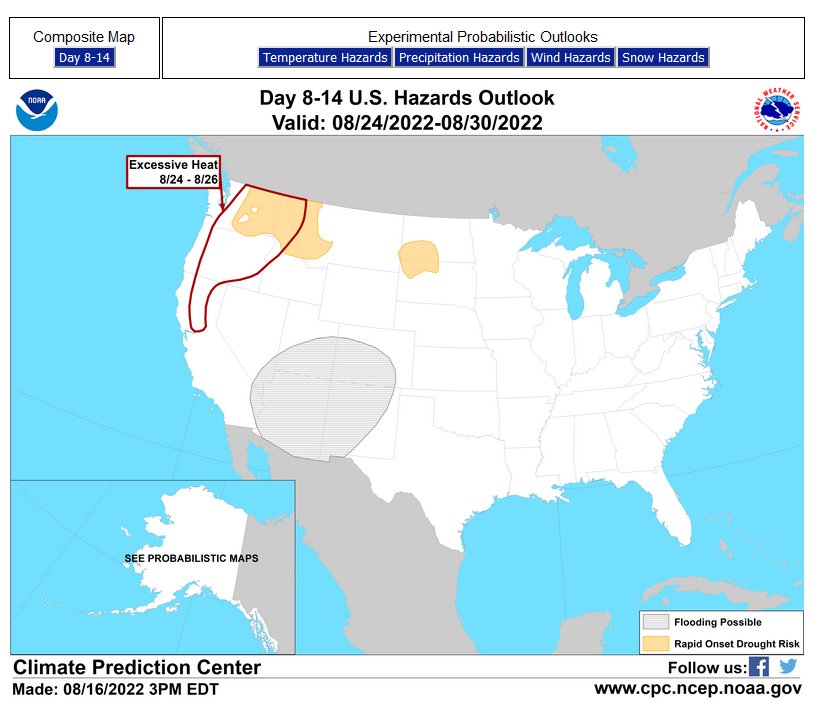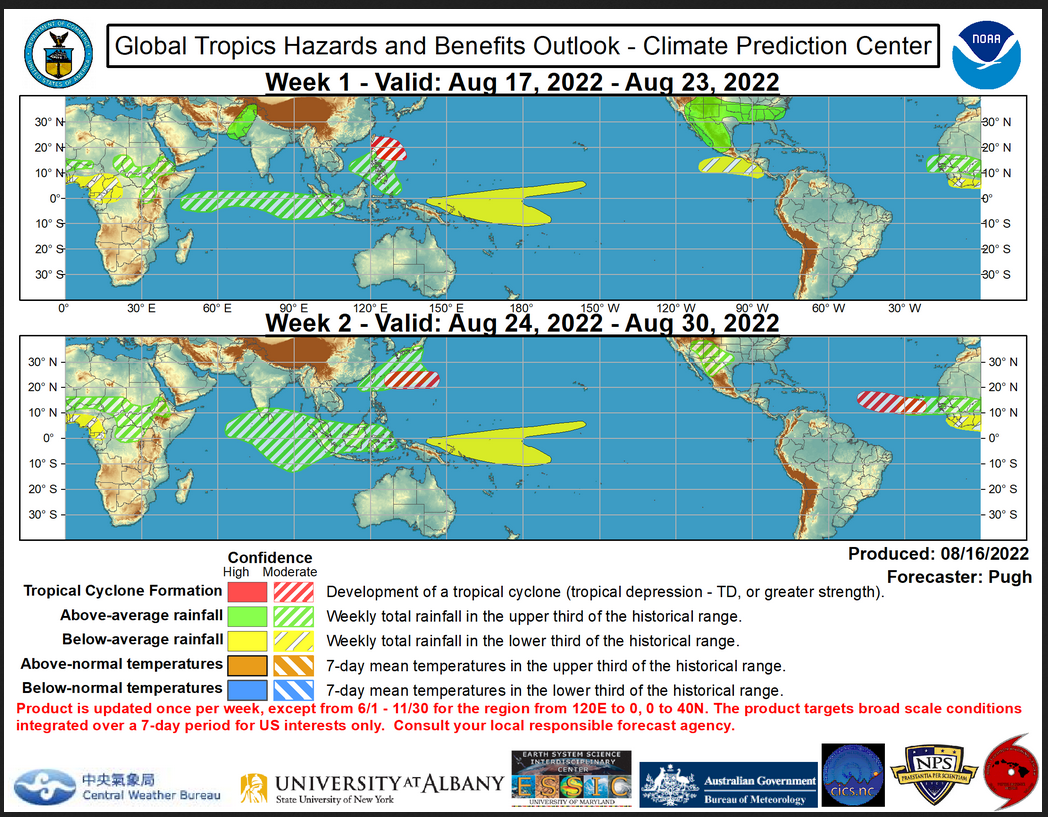Here is what we are paying attention to this evening and the next 48 hours from this evening’s NWS Forecast.
...Flash flood risk intensifies in the Southwest as an already active Monsoon season ramps up... ...Showers and thunderstorms remains persistant across the Southeast and Southern Plains... ...Hot weather continues for California and the Northwest with numerous heat advisories in place...
Continuation of the NWS Short Range Forecast (It is updated twice a day and these updates can be found here.
The flash flood risk across the Southwest associated with an already active Monsoon season will increase further over the next couple of days as a mid-level low associated with a former tropical wave leads to an increase in moisture and instability on top of the Monsoonal moisture already in place. There is a Slight Risk of Excessive Rainfall Thursday for portions of southwestern Utah and Arizona for areal average rainfall totals between 0.5-1", with locally higher totals possible across far southern Arizona closer to the influence of the mid-level low. The threat increases Friday for potentially much more siginficant rainfall, and a Moderate Risk has been issued for southeastern Arizona and southwestern New Mexico. Areal average rainfall totals increase to 2"+, a notably high amount for a widespread area which may lead to major flood-related impacts. Meanwhile, persistant shower and thunderstorm chances continue from the Southeast to the Southern Plains along a wavey stationary front which will remain in the area through the end of the forecast period. There is a Slight Risk of Excessive Rainfall for portions of southeastern Georgia as well as southeastern Louisiana and southern Mississippi where more continuous rounds of storms and high rain rates may lead to locally heavier rainfall totals of 3"+ and a few instances of flash flooding. Outside of the heavy rainfall threat, hot weather will remain in place across California and the Northwest under the influence of an upper-level ridge. There are numerous heat-related advisories in effect for the central Valleys of California, most of the interior Pacific Northwest, and the nothern Great Basin as highs reach into the upper 90s and low 100s Thursday and Friday. The heat threat will be most intense across the Colubmia River Valley in central Washignton where highs up to 105 and lows dropping only into the upper-60s and low 70s are up to 20 degrees above normal for the region. The urban areas from Seattle south to Portland will also see hot temperatures in the mid- to upper 90s Thursday before an upper-level trough approaches from the Pacific and the ridge shifts eastward, providing a return to more normal temperatures Friday and a break from the heat. Elsewhere, high temperatures approaching 100 along with high humidity will lead to heat indices around 110 for portions of southeastern Texas Thursday while highs will be around normal for the Plains and Midwest. Persistant clouds and some rain will lead to much cooler highs in the 60s in New England as a low pressure system departs northeastward into Canada. On Friday, a cold front moving southward through the Plains will drop temepartures into the 70s for the Northern Plains while warmer highs approaching 90 return to the Mid-Atlantic and southern New England.
Maps that relate the forecast to geography can be found by clicking Here for Day 1 and Here for Day 2.
Here is a 60-hour animated forecast map that shows how the short-term forecast is expected to play out.
If it needs to be updated click here.
HAZARDS OUTLOOKS
Click here for the latest complete Day 3 -7 Hazards forecast which updates only on weekdays. Once a week probably Monday or Tuesday I will update the images. I provided the link for readers to get daily updates on weekdays. Use your own judgment to decide if you need to update these images.
Worldwide Tropical Forecast
(This graphic updates on Tuesdays) If it has not been updated, you can get the update by clicking here
Detailed Maps and Reports for the Western Atlantic and the Pacific Oceans
Below are three maps that summarize the situation for the Atlantic, Eastern and Central Pacific. Additional information can be accessed by clicking HERE
First the Atlantic
Click to view the forecast map and have access to additional information https://www.nhc.noaa.gov/gtwo.php?basin=atlc&fdays=5
Then Eastern Pacific
Click to view the forecast map and have access to additional information https://www.nhc.noaa.gov/gtwo.php?basin=epac&fdays=5
Then Central Pacific
Click to view the forecast map and have access to additional information https://www.nhc.noaa.gov/gtwo.php?basin=cpac&fdays=5
And the Western Pacific
Click to view the forecast map and have access to additional information https://www.metoc.navy.mil/jtwc/jtwc.html
Some Intermediate-Term Outlooks
Links to “Outlook” maps and discussions for three time periods. Days 6 – 10, Days 8 – 14, and Weeks 3 and 4. An outlook differs from a forecast based on how NOAA uses these terms in that an “outlook” presents information from deviation from normal and the likelihood of these deviations.
You have to click on the links because they do not update automatically and I do not want to have stale images in the article. But it is not difficult to click on a link and you get a large image plus a discussion. On Fridays in a separate article, we will show the images and provide a link in this article that article. But remember what you will see is the images as of Friday. But here you can get the current images simply by clicking on them. Then hit the return arrow at the upper left of your screen to return to the article. You will not find this information easily anywhere else.
Right now you can find these maps here (We show them every Friday there but you can click above and find them).
World Forecast for Day 6 (Currently Set for Day 6 but the reader can change that)
World Weather Forecast produced by the Australian Bureau of Meteorology. Unfortunately, I do not know how to extract the control panel and embed it into my report so that you could use the tool within my report. But if you visit it Click Here and you will be able to use the tool to view temperature or many other things for THE WORLD. It can forecast out for a week. Pretty cool. Return to this report by using the “Back Arrow” usually found top left corner of your screen to the left of the URL Box. It may require hitting it a few times depending on how deep you are into the BOM tool. Below are the current worldwide precipitation and air pressure forecasts for six days out. They will not auto-update and right now are current for Day 6. If you want the forecast for a different day Click Here I will try to update this map each day but you have the link so you can access the dashboard and get a wide variety of forecasts.
 I mostly rely on the reader to interpret world maps. For this map, areas of expected precipitation for the date and time shown are clearly shown.
I mostly rely on the reader to interpret world maps. For this map, areas of expected precipitation for the date and time shown are clearly shown.
The number of High-Pressure systems shown is called the Wave Number. Maybe I will discuss WN someday. But it shows how many Rossby Waves there are around the World. Sometimes they are hard to count. Counting Low-Pressure systems should provide the same WN. Rossby Waves are the way the temperature distribution of the Planet remains in balance. It is basically the science of fluid dynamics. It can be very helpful in predicting the movement of weather patterns.
Month to Date Information
Month to date Temperature can be found at https://hprcc.unl.edu/products/maps/acis/MonthTDeptUS.png
Month to date Precipitation can be found at https://hprcc.unl.edu/products/maps/acis/MonthPNormUS.png





